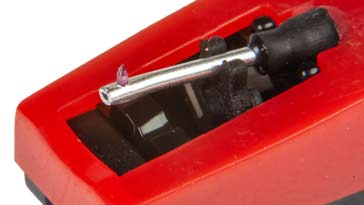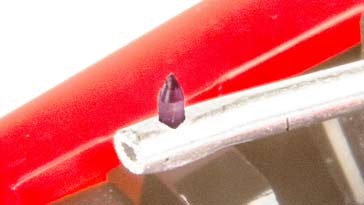Understanding the Vinyl Record Stylus
There is more to the stylus used for vinyl records than meets the eye, with types including conical, elliptical, Shibata and others they are finely honed for transcribing the vibrations in the grooves.
Vinyl Record Player Technology Includes:
Vinyl technology - the basics
Turntable
Pickup arm / tonearm
Pickup cartridge
Stylus technology
Although the term stylus is often used interchangeably with the overall pick-up cartridge when discussing vinyl record equipment and technology, the actual stylus is the small tip of the cartridge cantilever than is in contact with the record grooves.
This small stylus must stay in contact with the groove despite the enormous forces exerted upon it to ensure the faithful reproduction of the sounds contained within the grooves.

Vinyl record styli vs needles
Although people often refer to the styli used in modern vinyl record players, they are not needles, but finely manufactured styli.
The term needle is more correctly used to describe the steel needles used with the old gramophones that were in use prior to the invention of the modern vinyl record player.
The needles were made of hard wearing steel, and they also had much larger dimensions and therefore they are totally unsuitable for the modern vinyl records.
It is still possible to obtain the old needles for 78 wind-up gramophones, but it is necessary to go to specialist vintage gramophone dealers for these.
Modern vinyl record styli basics
Modern styli used for modern pickups are generally made from diamond to provide the required level of hardness to reduce wear and provide a long and useful lifetime.
Considering the enormous forces applied to the stylus, an incredibly hard wearing material is required for this - diamond is ideal.

It is important that any stylus used is not unduly worn, otherwise damage can result to the vinyl record. A correctly set up system and little worn stylus will not rapidly degrade the record groove, so it is always best to replace the stylus before any undue wear occurs.
When a stylus is worn, it should be replaced - typically after about 300 - 500 hours playing time.
The styli on any cartridge are replaceable and instructions will be found with the cartridge about how to do this.
Record styli materials
There are a number of materials used for record styli, but whatever the material it must be incredibly hard wearing:
- Use of diamond only stylus: The best option is to use what is sometimes referred to as a "nude" stylus, because it uses only diamond in the stylus. This gives the best transmission of the vibrations to the actual transducer via the cantilever. However it is also the most expensive. However, with industrially made diamond, the costs may not be as high as might have previously been expected.
- Composite stylus: Some of the lower end cartridges and their styli may be a composite construction having a diamond tip, but another hard material to interface the stylus tip to the cantilever.
- Sapphire: Another alternative, which is less used these days is to use a sapphire stylus instead of diamond. Although very hard, the sapphire wears more quickly and will obviously need replacement more often. The economics of this may be dubious these days.
Styli profiles & impact on performance
The profile of the stylus is also very important. There are several types of stylus profile that are used. Each type brings its advantages and disadvantages, so it is worth understanding what each type is.
- Spherical: Spherical styli are bar far the most commonly used type of styli and they are most basic profile. This type of stylus has a conical shape and the tip is spherical with a radius of around 0.6 to 0.7 mil, i.e. 15 - 18 microns.
They are lower cost because they are easier to manufacture, but they pick up less information from the record wall than other more sophisticated types.
The issue occurs when the contact span is so large compared to the wavelength of the groove vibration, that the stylus is not able to fully track the vibrations.
The actual contact span is 1.4 times the radius of the tip, i.e. 1.4 x 0.7 which is 0.98mil. Frequencies corresponding to this dimension are 9.8kHz for the outer groves of the disc and only 4.8 kHz for the inner grooves. This is because the distance traversed along the groove in the disc surface is much greater for each revolution on the outer edge of the record than further in. This is because the circumference is much greater further out.
A further issue occurs because the disc cutter for the master is triangular and because the stylus is conical, this results int he stylus being squeezed into a spurious vertical motion called the pinch effect. This occurs twice for each cycle and it results in second harmonic distortion.
- Elliptical: An elliptical stylus or bi-radial stylus have their sides polished so they read more of the groove, but are still at the more affordable end of the price spectrum.
The major radius of the elliptical stylus sits across the groove and its major radius is similar to that of a conical stylus. As a result it maintains the correct position in the groove, but having the shorter radius in the direction of the groove, it can correctly track the shorter wavelengths, i.e. higher frequencies much more accurately.
For an elliptical stylus with a minor radius f 0.3mil, the contact span is generally around 0.42 mil. The half wavelength frequencies for this are 23 kHz for the outer record grooves and about 11kHz for the inner most grooves.
As an elliptical stylus is closer to the shape of the disc cutter, there is considerably less of the pinch effect and this results in lower distortion levels.
Also as less area of the stylus is in contact with the disc, The levels of wear are theoretically higher, although it is generally accepted that this is not much of an issue in reality.
- Shibata or Ichikawa: This form of stylus uses a parabola instead of a cone shape. This achieves a contact area of four times that of the spherical stylus. This improves tracking, it reduces wear and also doubles the stylus resonant frequency.
There are various other formats for record styli including the Pranmanik and Van den Hul formats, but these are not widely used.
There is a lot more to the technology behind the stylus used for vinyl records than might be thought at first glance. Understanding the physics and general technology behind them enables a better understanding of the performance to be obtained.
 Written by Ian Poole .
Written by Ian Poole .
Experienced electronics engineer and author.
More Audio Video Topics:
HDMI
SCART
DisplayPort
DVI
Loudspeaker technology
Headphones & earphones
Bluetooth speakers
Stereo sound
Microphones
Audio compact cassettes
Vinyl record technology
Digital radio
DVB television
Return to Audio / Video menu . . .


